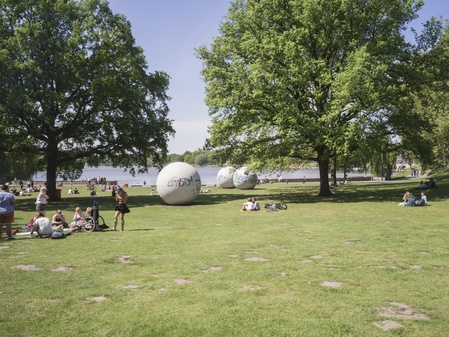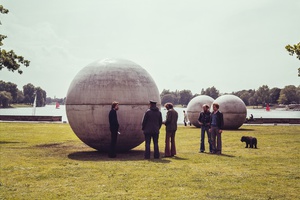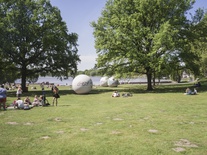Claes Oldenburg
Giant Pool Balls
1977
Installation comprising three reinforced concrete spheres
Sphere diameter, each 3.5 m
Location
Terraces on the north bank of the Aasee, permanent installation
Owner
City of Münster
Claes Oldenburg
* 1929 in Stockholm, Sweden
† 2022 in New York City, USA
When Claes Oldenburg was invited to participate in the first Skulptur Projekte in the 1970s, contemporary art in public spaces was still something of a novelty. The artist used Giant Pool Balls to envisage Münster as a huge playing field. Oldenburg frequently examines the aesthetics of everyday objects by scaling up their dimensions and placing them in a new context. A confrontation with proportion and scale likewise became a fundamental element of his joint works with Coosje van Bruggen, who made a significant contribution to the development of the spheres. The first stage of such projects is a social and historical analysis of the location in question. For Münster this involved stories of a cannonball remaining lodged in the city walls, as well as anecdotes about Münster's citizens being enthusiastic balloonists and aerial photographs of the city taken during balloon flights.
The proportions of the Giant Pool Balls are based on the relationship between the diameter of a pool ball and the playing surface of an ordinary pool table. The original suggestion envisioned an unlimited number of spheres located throughout the city. Each object was to be part of an imaginary whole, just as each location is a fragment of the city as a whole.1 However, given the resources available, this ambitious proposal had to be adapted to the circumstances of the 1977 exhibition, so that only a reduced version of three spheres was actually realised. As installed in the city of Münster, the relationship of the balls to each other would appear random, as if they had just been struck by a gigantic cue. The composition however was a conscious decision, their dynamic positioning suggesting the imagined motion of the balls, and enhanced by the movements of the surrounding sailing boats, cars, bicycles and joggers.
The 1977 exhibition catalogue raised the question of whether the Giant Pool Balls would have a disruptive presence in the park. Today, nearly four decades later, the spheres next to the Aasee are in no way perceived as either an obstacle or even a nuisance. Meanwhile the location has established itself as a popular meeting place and has become a city landmark, supplying the motif for such souvenirs as snow globes and the decoration for chocolate wrappers. Consequently Oldenburg’s work has also provided a means of understanding the controversial development of public art.
Clara Napp
1 Claes Oldenburg, Aus den Notizen über das Projekt Münster 1976–77. In: Klaus Bußmann and Kasper König (eds.), Skulptur Ausstellung in Münster 1977, exhib. cat.: Westfälisches Landesmuseum für Kunst und Kulturgeschichte, Münster, Münster 1977, 284–287, here 284.
Images
Location
- Still existing / Public Collection
- Removed
- In the museum


